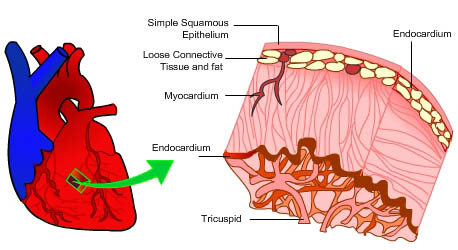The Cardiovascular System
The Heart
The Heart |
Cardiac Cycle |
The Blood |
Types of Arteries |
Blood Circulation |
Blood Pressure |
ECG

The heart is a chambered muscular organ that pumps blood received from the veins into the arteries, thereby maintaining the flow of blood through the entire circulatory system.
The human heart is a pear-shaped structure about the size of a fist. It lies obliquely within the chest cavity just left of center, with the apex pointing downward. The heart is constructed of a special kind of muscle called the myocardium or cardiac muscle, and is enclosed in a double-layered, membranous sac known as the pericardium. A wall of muscle, the septum, divides the heart into two cavities. The left cavity pumps blood throughout the body, while the right cavity pumps blood only through the lungs. Each cavity is in turn divided into two chambers, the upper ones called atria, the lower ones ventricles.
Venous blood from the body, containing large amounts of carbon dioxide, returns to the right atrium. It enters the right ventricle, which contracts, pumping blood through the pulmonary artery to the lungs. Oxygenated blood returns from the lungs to the left atrium and enters the left ventricle, which contracts, forcing the blood into the aorta, from which it is distributed throughout the body. In addition, the heart employs a separate vascular system to obtain blood for its own nourishment. Two major coronary arteries regulate this blood supply.
Layers of the Heart
The wall of the heart has three layers: the outer epicardium ( epi - = on, upon; cardia = heart), the middle myocardium ( myo - = muscle), and the inner endocardium ( endo - = within, inward). The epicardium is the visceral layer of the pericardium . The majority of the heart is myocardium or cardiac muscle tissue. The endocardium is a thin layer of endothelium that lines the chambers of the heart and the valves.

Pericardium
The pericardium ("around the heart") is a triple-layered fluid-filled sac that surrounds the heart. The outer layer of this sac is the fibrous pericardium . It is a strong layer of dense connective tissue. It adheres to the diaphragm inferiorly, and superiorly it is fused to the roots of the great vessels that leave and enter the heart. The fibrous pericardium acts as a tough outer coat that holds the heart in place and keeps it from overfilling with blood. Deep to the fibrous pericardium is the double layered serous pericardium . The serous pericardium is a closed sac sandwiched between the fibrous pericardium and the heart. The outer layer is the parietal layer of the serous pericardium and adheres to the inner surface of the fibrous pericardium. The parietal layer is continuous with the visceral layer of the serous pericardium or epicardium , which lies on the heart and is considered a part of the heart wall.
Myocardium
The myocardium ("muscle heart") is the muscular wall of the heart and consists mainly of cardiac muscle. The myocardium's elongated, circular, and spiral arranged networks of cardiac muscle cells, called bundles, squeeze blood through the heart in the proper directions: inferiorly through the atria and superiorly through the ventricles.
Endocardium
The endocardium is an innermost, thin, smooth layer of epithelial tissue that lines the inner surface of the heart chambers and valves

 Cardiac Cycle
Cardiac Cycle